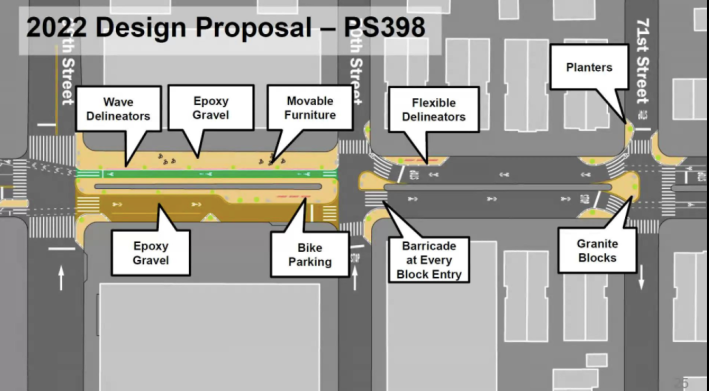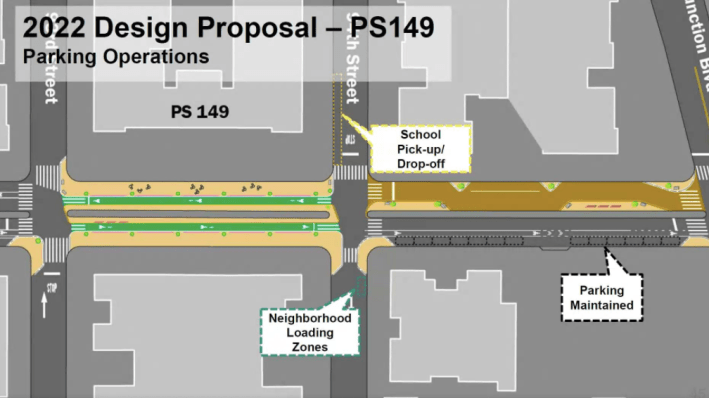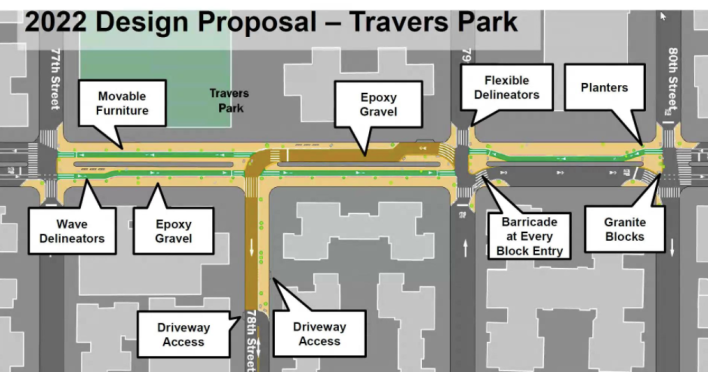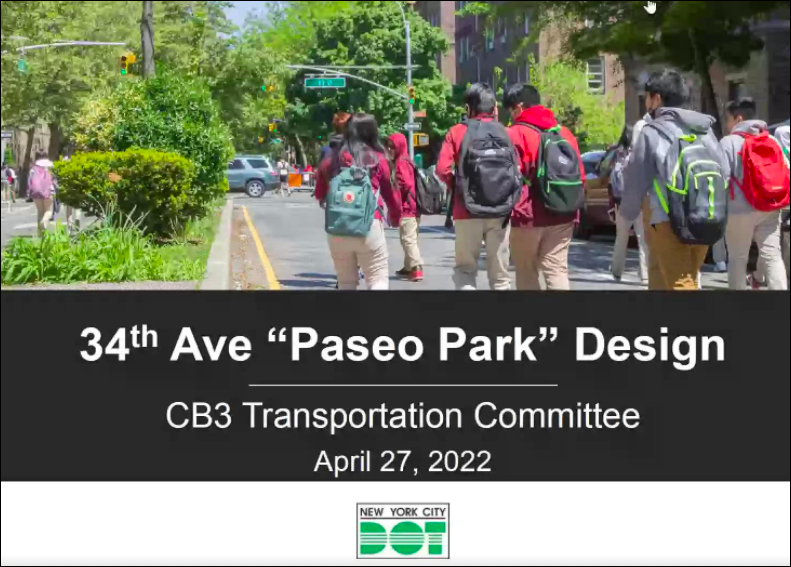Walk this way!
The Department of Transportation presented to Community Board 3 on Wednesday a final version of its long-in-the-making plan to ensure the permanence of the 34th Avenue open street, a plan the agency calls "Paseo Park" because, officials said, it would create a 1.3-mile stretch where "vehicles are guests" on five-mile-per-hour shared streets and would feature full pedestrianization of two whole blocks, plus five other half-blocks of the median-divided avenue.
The agency said it was motivated primarily by safety and by the higher numbers of pedestrians than vehicles for most of the day. There are seven schools on or within a block of 34th Avenue, and the open street has made school arrivals and departures radically different from the days of crashes and limited socializing. Students on the strip clearly prefer the car-free roadway. And city data show that car-free streets, especially 34th Avenue, are much safer.
"We will also be adding diverters at all intersections and really transforming vehicle use along the corridor," said Emily Weidenhof of DOT, adding, "34th Avenue will no longer be a thruway for vehicles."
Here are some slides from the DOT presentation on Wednesday night [Update: Here's the full proposal in PDF form]:
The local Council member Shekar Krishnan, who was elected on a platform of converting the open street into a "linear park" and started working with DOT even before he took office on Jan. 1, said he was overjoyed by the resulting plan.
"Communities like Jackson Heights, majority people of color and immigrants, deserve open space and street safety like everyone else," he told Streetsblog. "We have seen how vital 34th Avenue is for our community, which has some of the least amount of open space in all of New York City. This design improves pedestrian safety and expands accessibility for all people. I am most excited for the school plazas and the expanded public realm around Travers Park."
Specifically, the DOT presentation builds on the existing open street by deploying several elements from the agency's street design toolbox along the stretch of 34th Avenue between 69th Street and Junction Boulevard, where the roadway features one lane in each direction, divided by a thick cement median that gives the street its unique character.
Unlike an earlier presentation in October [PDF], all of the blocks of the open street will be reconfigured as "shared streets," where local car traffic is allowed, but kept to slow speeds, thanks to diverters, road treatments, chicanes and other clues.
There are further enhancements on a handful of other blocks:
School blocks
Several blocks with school on the roadway or just off — such as the north sides of the blocks between 69th and 70th streets, between 79th and 80th streets, and between 89th and 90th streets, plus the south sides of the blocks between 78th and 79th streets and between 82nd and 83rd streets — will get a full "plaza" treatment, meaning no cars are permitted at all; pedestrians get not only the sidewalk, but the curbside lane, too; a cyclists get a dedicated lane. It looks like this:

Parents were wondering why PS212 on the @34_ave #openstreet why their school wasn't taking advantage of the street as much as others along the corridor. So they held a fun dismissal event! @dawnsiff @NYC_DOT @OpenPlans @StreetsblogNYC @QnsBPRichards @voteshekar @KathyParkPrice pic.twitter.com/fdDsI60q5y
— Streetfilms (1,071+ videos!) (@Streetfilms) April 10, 2022
Full plazas
Also unlike the original October presentation, there will be two full plaza blocks — meaning no cars at all in either direction. Those are between 77th and 78th streets (in front of Travers Park) and between 93rd and 94th streets (in front of PS 149).
Here's what those look like:

Travers Park would form the core of what the DOT is now calling a green core of the neighborhood. Even though the westbound lane of the roadway between 79th and 78th streets is available for drivers, it will only be for local access so drivers can access a garage on 78th Street. Here's what the blocks in front of the park would look like:

"When you see the full plaza blocks, and 78th Street as a cul-de-sac, you see what a huge victory this is for us," said Luz Maria Mercado, a supporter of the linear park plan that has led to Paseo Park. "The DOT's presentation is a bold move in the right direction."
Mercado grew up in the neighborhood and was afraid to play in the street as a kid — but thanks to the open street, her 11- and 14-year-old children "can bike and walk around safely."
Like others at the DOT presentation, she singled out the peacefulness of the open street during its hours of operation from 7 a.m. until 8 p.m. daily.
"We all see what a big change happens at 8 p.m. when it becomes a highway again — the loud music, the speeding cars, the noise," she said. "It has been such a game-changer for this neighborhood to get rid of this thruway. It's now a residential haven."
The dictionary defines "paseo" as "a leisurely walk, especially in which young people may socialize with each other" — but there remain some members of the community board who were hardly in the mood to socialize with the DOT over its plan. Three members of the board — its chairman Frank Taylor, plus the co-chairs of the Transportation Committee, Ed Kiernan and Stephen Kulhanek — had sent the agency a letter on board stationery outlining what they presented as the board's "concerns" about the open street, though the letter was not shared with members of the committee.
"As a member of the committee, I am extremely disappointed that our committee chairs and board chair sent a letter to the DOT without consulting with members of the transportation committee," said Dawn Siff. "We didn't even learn of the letter until a week after it was sent. Among other things, their letter excoriated the DOT for lack of transparency."
In fact, the DOT has been painstakingly transparent during the two-plus-years-long process of making the emergency Covid-era open street into a permanent part of the neighborhood, which has among the least open space of any in the city. The agency has presented repeatedly to the community board, as well as to resident groups and groups.
In the end, the concerns raised by the three CB3 leaders were relatively minor and easy to solve. They included concerns about motorized scooters, some of which do indeed speed faster than the posted five-mile-per-hour speed limit; access for people with disabilities (the DOT says it has reminded Access-a-Ride drivers, for example, that they can drive on the open street); a lack of environmental review (an irony, given that residents say the air is cleaner now, thanks to the removal of cars for 13 hours a day); confusion over street vending rules; and concern about some programming locations.
DOT officials said they would continue to work with the board over these concerns. And they said the project does not need an environmental review because it falls under the agency's right to manage the city's roadways (though that position has been challenged in unsuccessful lawsuits in other neighborhoods, such as over the 14th Street busway or a "road diet" on Morris Park Avenue).
Kiernan declined to comment on his committee members' anger over the secrecy around the letter. He did during the two-hour virtual meeting say he is generally supportive of the open street.
The writing was on the wall for the bolder "Paseo Park" plan with the election of Eric Adams, who had signed a petition in support of a full linear park as a candidate for mayor.
At long last after being brow-beaten for months, the DOT officials — Jason Barney, Jessica Cronstein and Weidenhof — showed off their plans with more pride and fuller conviction than they had previously, several people pointed out.
“The DOT team has worked tirelessly with the community stakeholders on this project and it shows in the visionary design they proposed," said linear park supporter Donovan Finn. "I can only imagine it must be pretty gratifying to work on a project where they can know that they are doing truly groundbreaking design that will benefit thousands every day and set a new standard for how the city sees its public realm.”
Mercado sees that as evidence that the limited opposition is weakening further.
"I was watching the chat [during the meeting] and saw fewer negative comments than before," she said. "I think people are getting comfortable with the plan. I remember when they closed 78th Street [north of 34th Avenue] to expand Travers Park. There was so much opposition — but now if you tried to take it away and give it back to cars, people would protest. This is going to be the same way."
Implementation will begin in June, the agency said. In 2023, there will be "additional public space improvements" and proposals for major capital improvements.
How did we get here? All of our intense 34th Avenue coverage is archived here.






